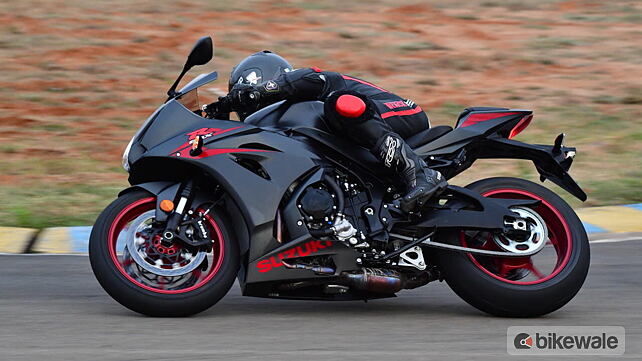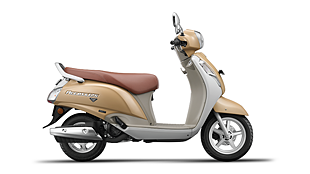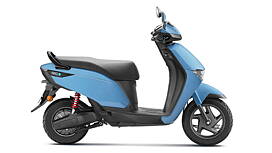Introduction

The GSX-R series is what truly defines Suzuki. The first – a 750cc – rolled out over three decades ago. It was followed by an 1100 and then in the year 2001 came the 1000cc.
The engine capacities, the styling, and the technology might have changed over the years, but the focus for the brand has remained constant: Any motorcycle that carries the GSX-R nomenclature must be track-focused. It might not be savage or mad or be the epitome of technological breakthroughs, but a GSX-R must handle; it must brake; and it must feel completely at home on a racetrack.
No surprise then that we are at Kari Motor Speedway to ride the latest generation GSX-R in both the standard R1000 and R1000R forms. You can read about the pricing and specs of these bikes by clicking on their names. And we expect the world from these GSXRs for it has taken Suzuki nearly a decade to come out with this 6th generation model. What’s more, it’s now claimed to be the most powerful, hardest accelerating and cleanest running GSX-R ever built.
There’s clearly a lot these bikes must live up to.
Power talk

On the engine front, besides a slight increase in capacity, the new GSX-R1000 features variable valve timing (VVT), stacked intake funnels and ride-by-wire. It also has a trick exhaust and all of this is part of Suzuki’s Broad Power System. These upgrades along with friction busting techniques and a higher compression ratio have landed the new R1000 with over 200bhp of power.
But, the idea was also to make the new GSX-R easier to ride and live with on the streets. So the VVT – which kicks in at a pre-defined rpm – allows for a fatter torque in the mid range as well as more power at the top. It’s the same with the stacked intake funnels or Dual Stage Intake, as Suzuki likes to call it.
Applied only to the first and fourth cylinders, these act like a pseudo variable intake. At lower revs most of the air enters through the longer funnel aiding torque. But, at higher revs, the airflow is concentrated at the base of the longer funnel and it flows straight into the lower, shorter funnel, helping with top end power.

The trick exhaust, says Suzuki, has been designed with the exact same purpose. Called the Suzuki Advanced Exhaust System (S-AES), it uses butterfly valves in the exhaust header balance tubes that connect both the 1st and 4th cylinder and the 2nd and 3rd cylinder. A balance tube that connects the headers of different cylinders helps reduce the backpressure, thus helping top-end performance. With S-AES, these servo-operated butterfly valves are closed in the low and mid rpm range, thereby boosting the torque characteristics.
Dynamic story

There’s also a new chassis at play here. Thanks to the change in the engine’s orientation, the distance between the front wheel and the swingarm pivot has reduced. This should make the bike feel more compact than it is. The new swingarm, however, is longer to add straight-line stability. In fact, the new R sits on a longer wheelbase than the bike it replaces. The new frame is also lighter and narrower which again should make the bike nimbler than before.
The changes don’t end there. As is the norm among litre-class bikes, the new R gets a full suite of electronics too. So, there’s a quickshifter, three riding modes and 10 levels of traction control. And of course, there’s the ABS. The functioning of these are ruled upon by the ECU which makes its calls based on feedback from seven different sensors. One of those is the IMU. It’s a six-axis system that reads pitch, roll and yaw. So, it’s very precise.

The racier twin, the GSXR1000R meanwhile, also gets a quickshifter for downshifts. And it features Launch Control. The latter is designed for club racers or drag fans to get the perfect launch. The R manages this by limiting the engine rpm and managing the throttle body opening as well as the ignition timing. Unfortunately, we didn’t have the time to try it out…
Ride out

We did however ride the bike on the track for a bit. But, it wasn’t long enough for us to be able give you a complete low down on its real world performance. Plus, the surface at Kari isn't in the best of shape, and that meant we had to proceed with double caution.
But, the one thing that shone through in those few laps was the friendly nature of the new GSX-R1000. We had the riding mode set to A and the traction control turned down to 4. But even then, the ease with which it turned into corners and then hooked up at corner exits on power just made the GSX-R feel like a much smaller and lighter bike than it is.

And if you have ever ridden at Kari you'd know it is a track peppered with tight corners and short chicanes. It's not the ideal hunting ground for a litre-class bike, but the R1000 with its feedback rich front end, great direction changing ability and of course a completely non-intrusive TC, never felt big or awkward or intimidating either.
Surprisingly, neither did its 200+ bhp motor. Sure, we never fully turned on the taps – there just wasn't enough room. But then we didn't need to. All that talk about Suzuki’s new Broad Power System does actually work. The GSX-R has a tremendous mid range, which allows you to use it as an automatic in 3rd gear if you choose to. I know I did. At a racetrack, no less.

So, it might not give you fire-breathing performance exiting bends or a manic 200kmph at the end of the straight, but you'd never be short on drive. This bike should work brilliantly on the road.
Ride it like a sports bike ought to be ridden, however, and the front end will stay light on you all the time that the throttle is pinned. And when you suddenly find yourself hanging on to the bars for dear life, you know the VVT has kicked in. Yes, the step-up in performance is that obvious.

And lest we forget, the new GSX-R1000 also sounds fantastic. That high rpm howl just makes you go weak in the knees and has you grinning from ear-to-ear involuntarily.
Like we said, we can’t give you a complete lowdown on the new GSX-R1000’s potential in the real world based on this short ride. But, we will have a full-fledged review for you soon. So stay tuned.
Photography by Aditya Bedre and Eshan Shetty
Gallery
1/13
Suzuki GSX-R1000 Action
Double Tap to Zoom














































